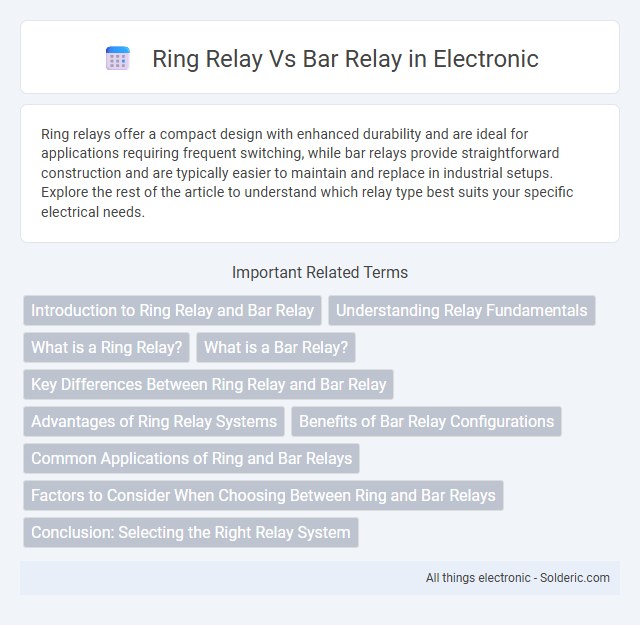Ring relays offer a compact design with enhanced durability and are ideal for applications requiring frequent switching, while bar relays provide straightforward construction and are typically easier to maintain and replace in industrial setups. Explore the rest of the article to understand which relay type best suits your specific electrical needs.
Comparison Table
| Feature | Ring Relay | Bar Relay |
|---|---|---|
| Structure | Circular coil ring | Linear bar coil |
| Magnetic Field | Uniform, radial field | Non-uniform, axial field |
| Operation Type | AC and DC applications | Primarily DC applications |
| Switching Speed | Faster switching | Slower switching |
| Durability | High due to ring design | Standard durability |
| Application | Telecommunications, signal switching | Power control, basic switching |
| Size | Compact, space-efficient | Bulkier design |
Introduction to Ring Relay and Bar Relay
Ring relay and bar relay are two common types of electromagnetic relays used in industrial control systems for switching electrical circuits. Ring relays feature a circular contact arrangement that provides uniform contact pressure and reliability, while bar relays utilize linear or bar-shaped contacts designed for straightforward, high-current switching applications. Both relay types serve essential roles in automation and protection circuits but differ in contact design and typical use cases, impacting their suitability for specific electrical tasks.
Understanding Relay Fundamentals
Ring relays feature a circular winding design that enables continuous current flow and quicker response times, making them ideal for high-speed protection in electrical systems. Bar relays use straight bar coils that generate magnetic flux proportional to the current, offering simplicity and robustness for standard relay applications. Understanding these fundamental differences helps you select the right relay type based on response speed and system requirements.
What is a Ring Relay?
A ring relay is a protection device used in electrical power systems to detect faults by monitoring current and voltage in a ring bus configuration, ensuring reliable fault isolation. It operates by receiving signals from multiple directions within a ring network, allowing quicker fault detection and minimizing service interruptions compared to bar relays. Understanding how a ring relay functions can help you design more resilient and efficient electrical protection schemes.
What is a Bar Relay?
A Bar Relay is a type of electrical relay that uses a flat bar-shaped contact to open or close circuits, providing reliable switching in control applications. Compared to Ring Relays, which use circular contacts, Bar Relays offer more straightforward construction, making them suitable for high-current and industrial environments. Understanding your system's requirements helps determine if the durability and simplicity of a Bar Relay are ideal for your application.
Key Differences Between Ring Relay and Bar Relay
Key differences between ring relay and bar relay lie in their structural design and application. Ring relays feature a circular coil arrangement offering uniform magnetic flux distribution, resulting in precise operation and minimal contact wear, while bar relays use straight bars as coils, providing simpler construction but less sensitive performance. Understanding these distinctions helps you select the appropriate relay type for specific electrical protection and control requirements.
Advantages of Ring Relay Systems
Ring relay systems offer enhanced reliability and fault tolerance by enabling continuous current flow even if one relay or connection fails, minimizing service interruptions. These systems provide efficient fault isolation and faster fault detection, which improves overall grid stability and reduces downtime. Their design supports better load distribution and scalability, making ring relay configurations suitable for expanding power networks and complex industrial applications.
Benefits of Bar Relay Configurations
Bar relay configurations offer increased reliability and faster fault isolation compared to ring relays, reducing system downtime and maintenance costs. They provide simpler protection schemes and easier fault detection by isolating individual sections without affecting the entire network. Your power distribution system benefits from enhanced stability and operational flexibility with bar relay setups, particularly in complex industrial environments.
Common Applications of Ring and Bar Relays
Ring relays are commonly used in telecommunications for signal routing and circuit switching due to their ability to handle multiple connections simultaneously and provide fault tolerance. Bar relays find widespread application in industrial automation and control systems, where precise switching and reliable isolation of electrical circuits are essential. Both types of relays play critical roles in complex electrical networks, ensuring efficient operation in environments ranging from telephony to manufacturing processes.
Factors to Consider When Choosing Between Ring and Bar Relays
When choosing between ring relays and bar relays, factors such as current capacity, mechanical durability, and contact arrangement play crucial roles. Ring relays offer compact design and consistent contact pressure, making them ideal for high-frequency switching applications, while bar relays provide higher current handling and robust construction suited for heavy-duty industrial use. Consider the application's voltage requirements, switching speed, and environmental conditions to ensure optimal relay performance and reliability.
Conclusion: Selecting the Right Relay System
Choosing between a ring relay and a bar relay depends primarily on the specific application and reliability requirements of the electrical circuit. Ring relays offer enhanced fault tolerance and redundancy, making them ideal for critical power distribution systems where continuous operation is crucial. Bar relays provide simpler design and cost efficiency, suitable for less complex applications with lower risk tolerance.
Ring relay vs bar relay Infographic

 solderic.com
solderic.com